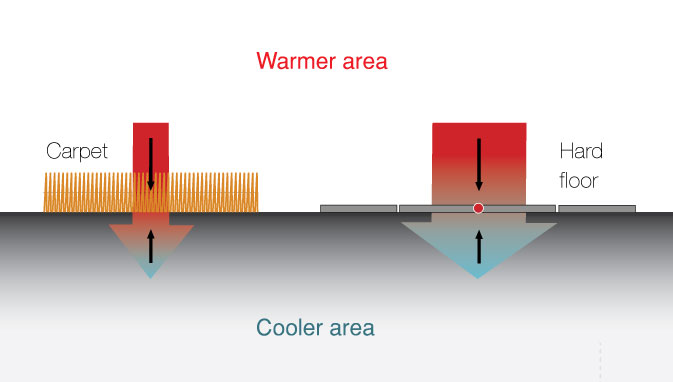Looking for ways to save on your energy bill? Better have a good look at your floor! Uninsulated floors account for 10 to 20% heat loss in the home. The right carpet can help you to reduce energy costs in heating and cooling as it’s an exceptionally good insulating material.
Research shows the insulation value of carpet can be up to 10 times higher than that of hard floor covering. The reason behind this is that carpet fibres are natural insulators with low heat conduction values. In addition, the surface pile of carpet with its millions of tiny fibres traps air and further increases its thermal insulation. The larger the area covered with carpet, the more insulation can be obtained. Wall-to-wall carpets are therefore preferred for maximum insulation.
Go for thick carpets with a deep pile
Thick carpets not only create a cosy atmosphere during those dark winter months, they are also ideal to retain the heat. Because in general, the thicker the carpet, the greater the thermal insulation value (R value) provided. The research shows that with carpet you could save up to 12% on energy. Installing it over underlay or carpet cushion will further increase the thermal insulation obtained.
Electrical Power Saving due to carpet installation in a one-room model house:
| Carpet |
Pile height (mm) |
Carpet Thickness (mm) |
Total weight (kg/m²) |
Energy Saving Heating % |
Energy Saving Cooling % |
| Cut pile |
5.0 |
7.3 |
1.722 |
8.6 |
8.0 |
| Cut pile |
7.0 |
9.2 |
1.963 |
11.3 |
10.4 |
| Cut pile |
10.0 |
11.7 |
2.257 |
12.8 |
11.7 |

We have numerous beautiful thick deep pile carpets in our range that meet these standards and thus also have a high insulation value. Carpets that are thicker and fuller, such as Invictus Magnificus, iSense Obsession and Sedna Yara, are therefore ideal for keeping in the heat.
The science of carpet insulation
Read more
Collapse
Ever wondered why the insulating effect of carpet is ten times higher than that of hard floors? The explanation is simple: physics teaches us that air is a poor conductor of heat and therefore a good insulator. That’s exactly why there is air between the two panels of glass in double glazing. The same logic goes for carpet: between the carpet fibres there is a layer of trapped air that acts as an insulator. Of course, the extent of this depends on the fibres and pile depth. The thicker the carpet, the better its insulating effect. Carpet with underlay delivers even better results.
Thermal Resistance of Materials
| Material |
Thermal Insulation* R value (m2K/W) |
| Concrete (10 cm thick) |
0.07 |
| Plywood (1 cm thick) |
0.08 |
| Carpet (1 cm thick) |
0.18 |
| Fibreglass insulation (1 cm thick) |
0.22 |
* The R-value is used to measure a material’s resistance to heat transfer or thermal resistance – the higher the R-value the greater the insulating effect.
Table 1. Carpet Buyers Handbook (R values converted to metric units used in Australia = m²K/W)
(Source: Carpet institute of Australia Limited)

This illustration shows that carpet reduces the heat flow through the floor by acting as an insulator
(Source: Dr. Lothar Siebel, Sachverständiger für Bauphysik, Aachen)

(Source: GUT Gemeinschaft umweltfreundlicher Teppichboden e.V)
Why carpeted rooms need less heating
Read more
Collapse
A carpeted floor feels warmer underfoot and does not require the heating that a smooth surface may. Leading ergonomics experts and engineers have discovered that in order to feel comfortable, the difference in temperature between your head and feet should not exceed 2.5 °C. This heat difference almost never occurs with a quality wall-to-wall carpet, because of its excellent thermal insulation properties. As carpet removes cold at the level of your feet and ankles, you would even feel more comfortable in a carpeted room where the temperature is one or two degrees lower than in a room with a hard floor.
This will allow you to turn the central heating thermostat down by a few notches without losing comfort. By doing so, you will add further energy savings to those shown above.

Source: Prof. Dr. Ing. Lothar Siebel, Sachverständiger für Bauphysik, FH Aachen